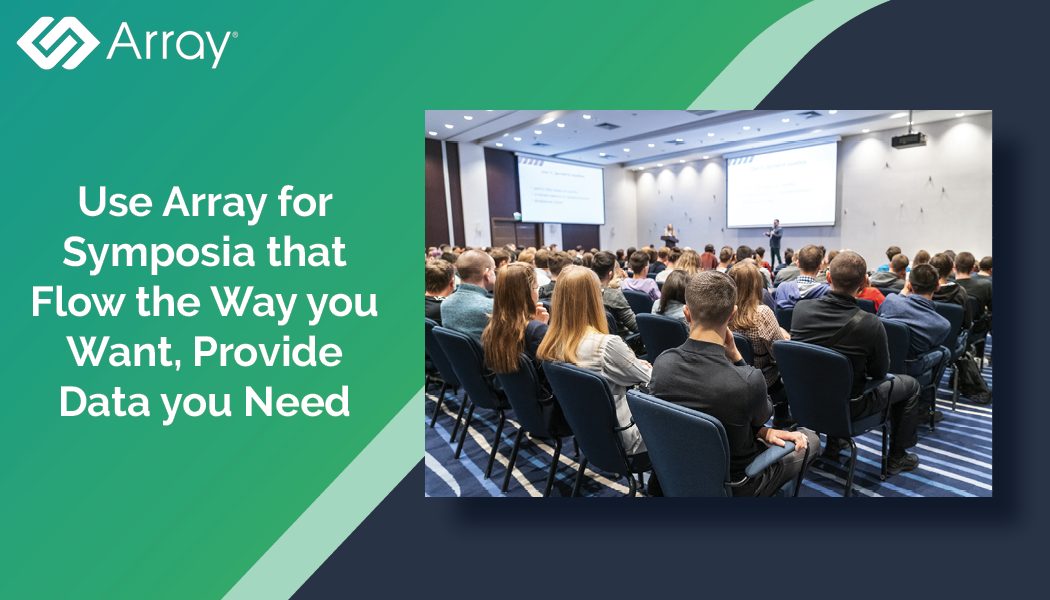Use Array for Symposia that Flow the Way you Want, Provide Data you Need
June 27, 2023 •Array Team

Satellite symposia offer tremendous opportunity to communicate with a potentially large group of HCPs who are ready to network, learn new things and make the most of their time on site at a conference. As advantageous as this is, CME providers face a lot of competition in the grant process as well as for these on-site audiences. A well-thought-out technology solution can help gather critical insights needed to satisfy grant providers and still enable the meeting to flow in a way that attracts and engages attendees.
“We help plan ways to elevate engagement while still being true to your style,” says Roland Baumgardner, vice president of account management at Array. “Our technology is nimble enough that we can help you map out how and when to use it to collect the metrics that are most important to you, while not detracting from what makes your program unique to attendees.”
CME providers generally attract their audiences by having sought-after and dynamic faculty and a relevant and timely topic. More than any other meeting type, CME programs also develop unique meeting formats focused on the attendee experience. In doing so, some use Array’s managed iPads® to present content that is synchronous to and directly supports the presentation taking place. Others focus more heavily on a discussion and use the technology to provide informative slides attendees can peruse at will. The variety of meeting styles presents both challenges and opportunities for engagement and analytics tools.
A meeting that has attendees following slide-by-slide will incorporate these tools in a way that has everyone land on and employ them at a designated time. When the discussion doesn’t coincide with slides being cued, however, there has to be a plan of how to use them in a highly engaging way. Array works with partners to identify what they need from engagement and analytics in the planning stage to provide the best outcomes.
“We help them strategically incorporate tools to maximize engagement and seamlessly fit the meeting flow,” says Mark Garcia, vice president of account management at Array.
While the uniqueness of each CME program may be attractive to attendees, data gathered throughout is critical to organizers. The common objective at a CME program is to share the latest, greatest information about a particular medical topic. To prove return on that objective, CME providers need data that demonstrates learning. Actionable insights drawn from that data can also be used to plan future symposia. Array’s engagement technology can collect relevant data via polling, gamification, surveys, pre-test and post-tests, as well as by recording slides saved. Many organizations use proprietary or third-party games or escape rooms as differentiators for their meetings and Array can seamlessly incorporate these as well.
“Organizers generally receive more audience questions via Array technology than they do from another type of device. There is even more engagement with Array from slide sharing, games and third-party games than if someone were participating on their phone or laptop,” says Garcia. “Each of these interactions is an opportunity to gather valuable metrics.”
The outcomes report Array provides helps CME providers satisfy the requirement of a follow-up report to the stakeholder. It includes evaluation data, polling data, and percent of attendees whose knowledge improved from the pre-test to the post-test. It also adheres to the strict regulations under which CME providers operate, including not identifying individuals.
“We work with our partners to identify the demographic information they will need to aggregate the data in a way that is compliant and also most useful to them,” says Garcia. “The data often includes things like attendees’ role, years’ experience, what setting they work in and such.”
CME providers then siphon through the data to provide insights in the outcomes report such as, for example, ‘Doctors in the northeast got question one wrong more often,’ or ‘Nurses in the southwest weren’t as up to speed on these elements of the training materials as those in the east.’ By combining insights gained directly from satellite symposia with other layers of research, they can develop future needs assessments that will be used to apply for the next round of grants.
Array’s comprehensive planning support, meeting technology and after-event insights can optimize CME programs to achieve multiple goals. Organizers can create the experience they want for attendees while gathering the data needed to demonstrate success to stakeholders. The in-depth insights gained (either individually or aggregated across multiple events) provides the advantage of knowing what topics CME providers need more training on and find most interesting to help make the case for the next grant application.


